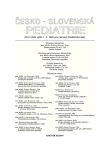The Use of Growth Models for Construction of Velocity Curves of Somatic Characteristics Based on Data of Semilongitudinal Study
Authors:
P. Sedlák 1; P. Bláha 1; L. Jiroutová 1; M. Brabec 2,3; J. Vignerová 2
Authors‘ workplace:
Katedra antropologie a genetiky člověka Přírodovědecké fakulty Univerzity Karlovy, Praha
vedoucí prof. RNDr. Z. Šmahel, CSc.
1; Státní zdravotní ústav, Praha
ředitel MUDr. J. Volf, Ph. D.
2; Oddělení nelineárního modelování a neuronových sítí, Ústav informatiky AV ČR, Praha
ředitel prof. RNDr. J. Wiedermann, DrSc.
3
Published in:
Čes-slov Pediat 2007; 62 (3): 133-145.
Category:
Original Papers
Overview
The dynamism of growth of stature and all other somatic parameters of the child give a true picture of the growth curves, which indicate the velocity of growth of a given parameter in individual age periods, expressed in the form of increments over a calendar year.
The velocity curves are constructed on the basis of data of longitudinal growth studies, providing g the data on individual course of growth with respect to individual variability in a given population. The mean growth curves of the given characteristic the serve as standards for the evaluation of his/her growth velocity, which is – in basic physical parameters, such as stature – a limiting criterion in the diagnostics of growth disorders. The prerequisite of a longitudinal study is a long-term observation of the same individuals and their repeated examination in precisely defined intervals. Various complications follow, including high organisational requirements of the project, mostly very limited size of the cohort and gradual loss of representative qualities of the group, where numerous individual fail to show up in repeated examinations. The loss of up-to-dateness is a problem. The given shortcomings of a longitudinal study may be solved by selecting a semi-longitudinal study, organised in such a way that it is a short longitudinal observation of different age groups of individual which occurs at the same time. When the study is finished, the individual groups are connected at a precisely defined age. The advantage of a correctly designed connected semilongitudinal observation is the possibility to collect a representative series of data in a short period of time. Such data can be used due to suitable selected mathematical models for the construction of velocity curves of physical parameters.
In the years 1997 to 2000, a total of 1925 children (990 boys and 935 girls) were examined by anthropometric methods at the age of 6–15 years. Anthropometric measurements were precisely in half-year intervals in such a way that the resulting matrix of data fulfilled the conditions of connected longitudinal observation. The authors followed 29 somatic characteristics on the whole, characteristics of the broth dynamics of stature, sitting height, subischial length and the length of upper extremity. For the construction of the mean growth curves the authors selected a model of linear regression with mixed effects. The mean distance curve of the parameters was constructed as a polynomial of 7th degree. The mean velocity curve was then reached by means of derivative equation of distance curve. The used mathematical model was sensitive enough to detect both most prominent growth accelerations in the childhood – midgrowth spurt (MGS) a pubertal spurt (PS). Local maxima and minima of individual spurts and inflexion points were calculated. Based on these characteristics the authors performed a detailed analysis of the growth dynamism of individual growth attributes and determined the average period of time of individual stages of both growth spurts. In an orientational comparison of the age characteristics of velocity curves of the semi-longitudinal cohort with the mean values of the Zurich longitudinal study a younger age of the onset and peak of PS in the present children was confirmed.
Key words:
growth models, growth velocity curve, growth dynamism, semi-longitudinal reseach
Labels
Neonatology Paediatrics General practitioner for children and adolescentsArticle was published in
Czech-Slovak Pediatrics

2007 Issue 3
Most read in this issue
- Effects of Short-term and Long-term Usage of Cannabinoids
- Antiepileptic Drugs and Lactation
- Hereditary Melanoma Resulting from Mutation in the Tumour Suppressor Gene NBS1
- The Use of Growth Models for Construction of Velocity Curves of Somatic Characteristics Based on Data of Semilongitudinal Study
